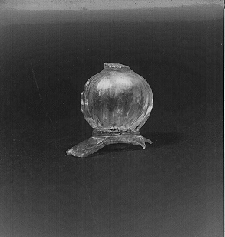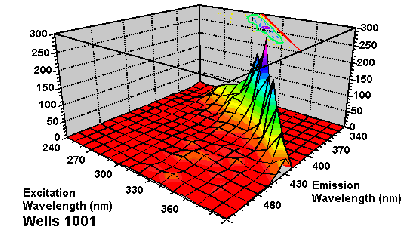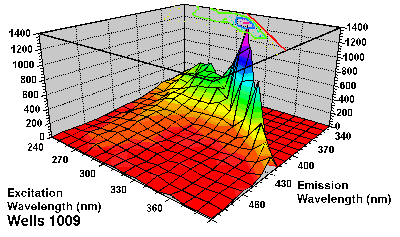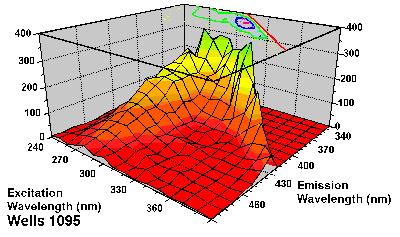

The three glasses featured here were all excavated in the grounds of Wells Museum and date from a period of five or six years when the English glass industry was maturing rapidly. The earliest of these glasses (1001) dates from about 1675 and is of a type usually associated with the London glass-seller John Greene. This glass is probably not Venetian, but a contemporary English product. Its simple form and the thicker, clearer, glass from which it is made, show it is a later one of the type. It is made of a potash glass that does not contain lead.
The other two fragments (1009, 1095) are tapering stems. Both show signs of having had 'seals' applied to their stems. The first sure mention of a glass maker using a seal was in the London Gazette for 5th October 1676, although a mention six months earlier may also refer to this. A year later it was stated that George Ravenscroft was using a raven's head seal. Most of the surviving glasses marked with his seal are made of glass containing lead oxide (lead glass). Documents also mention a Royal-arms (16th April 1683) seal. The seal on 1009 is now missing and the seal on 1095 is difficult to decipher. It does not match any known seal, and may be a crown. Whether this is the same as the Royal arms mentioned earlier is unsure. Sealing drinking glasses probably stopped in 1684. Fluorescence analysis shows both stems are made of glass of lead, but 1009 has about twice the quantity of potash in it; the white surface weathering on it may indicate that lime was also used in the glass batch. 1009 is the earlier glass, since its stems is short and straight-sided. With time, the stems became longer and more in-curved. 1095 shows clear evidence of criselling ; due to the use of an unstable glass mixture. Progressively loss of alkali from the glass results in a network of fine surface cracks. If the process is allowed to continue the glass will eventually disintegrate. Ravenscroft recognised he had a problem with criselling before 1676, but none of the manufacturers solved it completely. 1095 probably dates from about 1680.






Scientists have known that glass fluoresces for over a hundred years. In the 1950s there was interest amongst glass makers in using this fluorescence as a means of analysing glass, but little serious work was done on the technique. For the past few years we have been developing the technique for application to excavated English 17th-century drinking glass. The analysis of these three glasses found at Wells Museum is one of the first full applications.
What makes glass fluoresce? The answer is tied up in atomic physics and quantum mechanics. Within atoms, electrons orbit about a central nucleus. If a packet of light energy (a photon) is absorbed by the atom, it causes one of the electrons to move out to a farther orbit. As described by quantum mechanics, atoms will only absorb radiation which has the right amount of energy to match that needed to make one of the electrons jump. A photon's energy is dependent on its wavelength (or 'colour'), with violet being higher energy than red. However, an atom with an electron out-of place is not stable for long, so the electron falls back, giving off another 'photon' of energy. Some energy is lost, so the photon given off is shifted towards the red end of the spectrum compared with the one absorbed. Both the emitted colour and the colour that excites it are characteristic for each atom. In gasses, all the atoms of one chemical element behave the same and excitation and emission takes place over very narrow bands. Glass, however, is a disordered solid with some atoms being packed in tight and others with a lot of space. This means that excitation and emission take place across wide bands.

A fluorescence spectrometer is a piece of equipment that allows the colour of the excitation light shining on the sample to be controlled and can measure the amount of light being given off at different wavelengths. Naturally the measurement wavelengths need to be away from the excitation wavelengths otherwise they get swamped by reflections etc. For glass we use long-wavelength ultraviolet light for excitation (240 - 390 nm wavelength) and measure the emissions across most of the visible range (340-640 nm) ensuring that the emission wavelength is at least 40 nm above the excitation wavelength. A significant amount of lead in glass shows up as a peak output centred on about 360 nm with 280 nm excitation. The most notable outputs on all three Wells glasses is from potash, which gives a range of peaks with a maximum somewhere around 380 nm with 330 nm excitation. By logging the outputs in a computer it is possible to produce contour plots across the whole range and find out a lot about the materials used and the way the glass was melted.
We wish to record our thanks to Wells Museum, and particularly Chris Hawkes, for the opportunity to record and analyse these important glasses.
A more detailed discussion on the fluorescence of different components in glass can be found in this report. science.htm